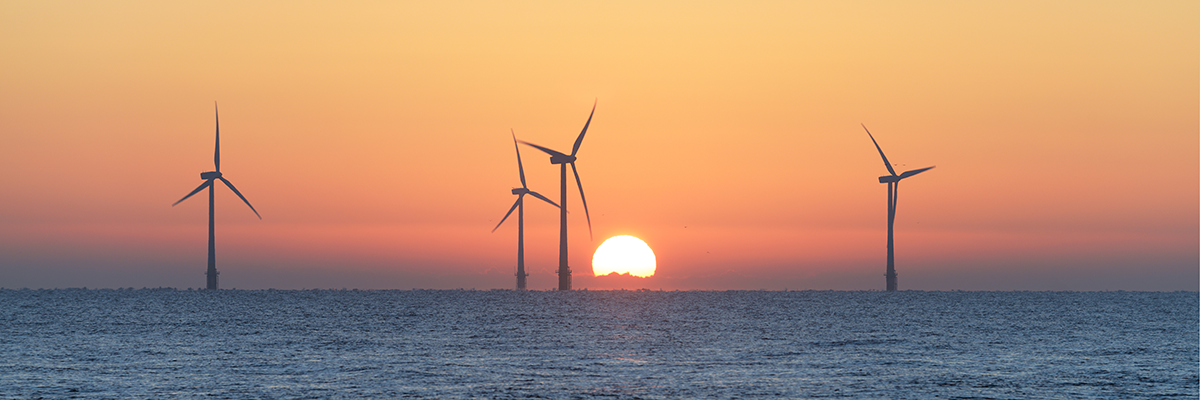As the developing US offshore wind industry continues its ambitious growth and build out, there is a need for confident assessments of potential energy production within the different Wind Energy Areas (WEAs). Over the next decade of offshore wind growth, project financing and operation will depend heavily on accurate and precise energy analysis. Current best practices for onshore wind resource and energy yield assessments have been well developed over several decades, but offshore assessments present unique challenges that need a modified approach.
Considering the significant industry interest in the WEAs in the New York Bight as well as the presence of publicly available data there, we undertook an offshore wind study for a hypothetical wind project located there to present the recommended technical approach for determining a layout and accurately assessing energy yield.
Our efforts can help estimate energy production in support of the rapidly growing US offshore market and provide guidance for all future offshore projects.
New York Bight offshore wind project: accurately assessing energy yield
For the study, we focused on the New York Bight East Call Area and assumed a minimum capacity bidding requirement of 1,000 MW. Data from the New York State Energy Research and Development Authority’s (NYSERDA) Eolis E05 floating lidar buoy and a combination of land-based and National Oceanic and Atmospheric Association (NOAA) weather buoy observations were used to represent regional atmospheric conditions. The combination of multiple sources to estimate atmospheric conditions provides the needed flexibility when determining the offshore wind resource potential. It also reflects how future offshore wind projects may develop where fixed bottom met mast installations are no longer considered due to cost and permitting challenges coupled with emerging confidence in the accuracy of floating lidar data.
The wind energy assessment process
Our study investigated multiple critical factors within the wind energy assessment process. Regarding long-term adjustment, we recommend a measure-correlate-predict (MCP) approach where shorter duration on-site measurements exist, with the skill of the MCP interrogated to guide the final selected approach. It is important to consider not only the accuracy or potential bias of the long-term mean wind speed, but the directional and wind speed frequency distribution estimate as well.
Vertical wind shear predictions in the offshore field are especially sensitive due to a combination of data collection techniques and the temperature gradients that exist over water. Collection and observations in the offshore environment usually occur at lower levels than the planned WTG hub-height. When the collection shortcomings are combined with the temperature gradient it can lead to over-prediction of energy production due to a non-uniform shear profile. Natural Power found a mean annualized shear exponent of 0.10 at the hypothetical project, typical of offshore shear, and noted a wide range of seasonal shear values.
How temperature affects wind energy production offshore
Hub height temperature is an important consideration for both density estimation for power curve calculations as well as to estimate any temperature-related turbine losses from extreme temperature cut-outs or derates. With the high heat capacity of the ocean, the temperature lapse rate typically will reverse sign (i.e., warmer with height) during summer when the ocean cools the lowest levels. This can be significantly variable from site-to-site dependent on ocean and atmospheric conditions. The lapse rate assumption and application can mean the difference in a large versus small temperature derate loss estimate for a project
The results of the study and what needs to be considered for offshore sites in the US
Natural Power employed multiple commercial energy calculation models as well as several wake model configurations with various settings that are used across the industry. Finally, we assessed default offshore secondary losses to conclude a total annual loss of a 21.7% with a 47.0% net capacity factor. The results for the study were found to be typical for offshore regions with similar wind resource.
For offshore sites in general, there is a relatively small gradient in wind resource. Over the area examined, speeds range from just under 9.8 up to 10 m/s. As the industry moves into very large, multi-GW projects over large spatial areas, it becomes important to understand both the applications and limitations of various modeling resources when conducting spatial modeling. Additionally, environmental inputs like sea surface temperature, coupled with wave and wind models, will be needed to inform boundary layer schemes at more complex sites. For the study, we modeled a hypothetical 14 MW turbine with a 238 m rotor diameter and 140 m hub height along with a 1x1 km array spacing. It should be noted that offshore layout optimizations must often be balanced by other common external limiting factors such as restrictions involving fishing grounds, seafloor features, Department of Defense, and shipping lane requirements.
Adjusting onshore approaches to solve the challenges of offshore projects
Offshore wind farms present challenges that must be addressed with solutions tailored to the offshore environment at all phases of the project, including the measurement campaign design, suitability of the turbine technology, modeling of the long-term wind climate and more. By adjusting onshore approaches to fit offshore projects, the wind industry can build larger, more efficient, longer lasting and more profitable wind farms for years to come.
Need help with your offshore project or want to know more about this study?
To find out more and access the full results of this study, please contact John Tarzian at johnt@naturalpower.com. We also presented the results of the study at American Clean Power’s CLEANPOWER 2021 Virtual Summit.
To learn more about how Natural Power can assist with your project, visit us here.

